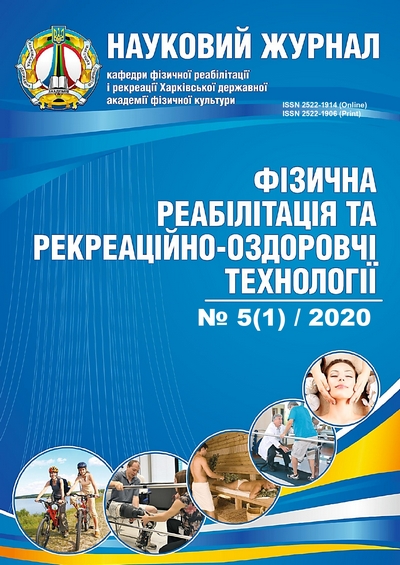Обґрунтування програми фізичної терапії пацієнтів з діагнозом адгезивний капсуліт на післялікарняному етапі
DOI:
https://doi.org/10.15391/prrht.2020-5(1).10Анотація
Мета.Обґрунтування програми фізичної терапії при адгезивномукапсуліті з урахуванням доказовості втручань у післялікарняному періоді. Методи дослідження. - аналіз літературних джерел з наукометричних баз Physiopedia, CochraneCentralRegisterofControlledTrials, PEDro, MEDLINE / PubMed, Scopus та WebofScience, системний аналіз, синтез та узагальнення науково-методичної літератури. Результати. Фізикальне обстеження, використання шкал ASES, DASH та SPADI рекомендовані для клінічного обстеження з метою встановлення порушених доменів МКФ та цілей фізичної терапії. Серед втручань, які найчастіше та з максимальним ефектом застосовувалися у сучасних дослідженнях були: навчання пацієнтів, терапевтичні вправи, мобілізація суглобів, низькоінтенсивна лазеротерапія. У дослідженнях було доведено ефективність домашніх занять, що також обов’язково враховується у реабілітаційні програмі. Проаналізовано використання пропріоцептивної нейро-м'язової фасилітациї у програмах реабілітації у систематичному огляді, тому доречно використовувати цю методику додатково до стандартної програми реабілітації. Висновки. При створенні програми фізичної терапії при АК необхідно орієнтуватися на повне відновлення рухових функцій у плечовому суглобі, встановлювати довго – та короткотривалі цілі в залежності від порушень діяльності та участі за МКФ, втручання потрібно підбирати з урахуванням ступеню доказовості методів та відповідно поставленим цілям, з вимірюванням отриманих результатів.
Ключові слова. Адгезивний капсуліт, заморожене плече, плече-лопатковий больовий синдром, фізична терапія.
Посилання
Бабко, А. М. Аналіз результатів ортопедичного лікування хворих на ревматоїдний артрит з ураженням верхніх кінцівок (2014). Вісник ортопедії, травматології та протезування, 3, 44–49.
Герцик А. (2016). Створення програм фізичної реабілітації/терапії при порушеннях діяльності опорно-рухового апарату.Слобожанський науково- спортивний вісник, 6 (56), 37–45.
Самусенко, І.В., Бур’янов, О.А., Волошин, О.І., Нечипорчук, С.Л., Даниленко, І.В., Кухарук, М.І. (2011). Відновне лікування пацієнтів з післятравматичними контрактурами та адгезивнийкапсулітом плечового суглоба. Літопис травматології та ортопедії,1-2 (21-22), 127-128.
Сергієнко Р.(2016, березень). Біль у плечі: завдання для роздумів. “Здоров’я України”, 6 (379), с. 30.
Сергієнко, Р. (2006). Діагностика та лікування адгезивногокапсуліту плечового суглоба. . (Дис. канд. мед. наук). АМН України; Інститут травматології та ортопедії, Київ.
Страшко Є.Ю., Іваницький І.В., Іваницька Т.А. (2019). Ефективність схеми реабілітації з використанням теорії м’язових спіралей у пацієнтів із плечолопатковим больовим синдромом за даними зсувнохвильовоїеластометрії. Актуальні проблеми сучасної медицини. Вісник української медичної стоматологічної академії, 19, 2 (66), 68-70.
Agarwal, S., Raza, S., Moiz, J. A., Anwer, S., &Alghadir, A. H. (2016). Effectsoftwodifferentmobilizationtechniquesonpain, rangeofmotionandfunctionaldisabilityinpatientswithadhesivecapsulitis: a comparativestudy. Journalofphysicaltherapyscience, 28(12), 3342–3349. https://doi.org/10.1589/jpts.28.3342
Ali, S. A., &Khan, M. (2015). Comparisonforefficacyofgeneralexerciseswithandwithoutmobilizationtherapyforthemanagementofadhesivecapsulitisofshoulder - Aninterventionalstudy. Pakistanjournalofmedicalsciences, 31(6), 1372–1376. https://doi.org/10.12669/pjms.316.7909
Beutler A. (2018). MusculoskeletalTherapies: AdjunctivePhysicalTherapy. FP essentials, 470, 16–20.
Cho, C. H., Bae, K. C., &Kim, D. H. (2019). TreatmentStrategyforFrozenShoulder. Clinicsinorthopedicsurgery, 11(3), 249–257. https://doi.org/10.4055/cios.2019.11.3.249
Duzgun, I., Turgut, E., Eraslan, L., Elbasan, B., Oskay, D., &Atay, O. A. (2019). Whichmethodforfrozenshouldermobilization: manualposteriorcapsulestretchingorscapularmobilization?. Journalofmusculoskeletal&neuronalinteractions, 19(3), 311–316.
Ewald A. (2011). Adhesivecapsulitis: a review.Americanfamilyphysician, 83(4), 417–422.
Gaspar, P. D., &Willis, F. B. (2009). Adhesivecapsulitisanddynamicsplinting: a controlled, cohortstudy. BMC musculoskeletaldisorders, 10, 111. https://doi.org/10.1186/1471-2474-10-111
GutiérrezEspinoza, H. J., Pavez, F., Guajardo, C., &Acosta, M. (2015). Glenohumeralposteriormobilizationversusconventionalphysiotherapyforprimaryadhesivecapsulitis: a randomizedclinicaltrial. Medwave, 15(8), e6267. https://doi.org/10.5867/medwave.2015.08.6267
Hawk C, Minkalis AL, Khorsan R, etal. SystematicReviewofNondrug, NonsurgicalTreatmentofShoulderConditions. J ManipulativePhysiolTher. 2017;40(5):293‐319. doi:10.1016/j.jmpt.2017.04.001Beutler A. (2018). MusculoskeletalTherapies: AdjunctivePhysicalTherapy. FP essentials, 470, 16–20.
Hee-RaShin, KyungtaePark, Sung-HuAn, Soo-JiPark, Ji-HyangGu, Eun-JungLee, Ji-EunLee, Jin-BongChoi, Seung-RyongYeom (2020). Chunamanualtherapycombinedwithacupunctureandcuppingforfrozenshoulder (adhesivecapsulitis): multicenter, randomized, patient-assessorblind, clinicaltrial. EuropeanJournalofIntegrativeMedicine, 33. https://doi.org/10.1016/j.eujim.2019.101012.
Kelley, M. J., McClure, P. W., &Leggin, B. G. (2009). Frozenshoulder: evidenceand a proposedmodelguidingrehabilitation. TheJournaloforthopaedicandsportsphysicaltherapy, 39(2), 135–148. https://doi.org/10.2519/jospt.2009.2916
Kelley, M. J., Shaffer, M. A., Kuhn, J. E., Michener, L. A., Seitz, A. L., Uhl, T. L., Godges, J. J., &McClure, P. W. (2013). Shoulderpainandmobilitydeficits: adhesivecapsulitis. TheJournaloforthopaedicandsportsphysicaltherapy, 43(5), A1–A31. https://doi.org/10.2519/jospt.2013.0302
Leung, M. S., &Cheing, G. L. (2008). Effectsofdeepandsuperficialheatinginthemanagementoffrozenshoulder. Journal of rehabilitationmedicine, 40(2), 145–150. https://doi.org/10.2340/16501977-0146
Noten, S., Meeus, M., Stassijns, G., VanGlabbeek, F., Verborgt, O., &Struyf, F. (2016). EfficacyofDifferentTypesofMobilizationTechniquesinPatientsWithPrimaryAdhesiveCapsulitisoftheShoulder: A SystematicReview. Archivesofphysicalmedicineandrehabilitation, 97(5), 815–825. https://doi.org/10.1016/j.apmr.2015.07.025
Page, P., &Labbe, A. (2010). Adhesivecapsulitis: usetheevidencetointegrateyourinterventions.NorthAmericanjournalof sportsphysicaltherapy : NAJSPT, 5(4), 266–273.
Ramirez J. (2019). AdhesiveCapsulitis: DiagnosisandManagement. Americanfamily physician,99(5), 297–300.
Russell, S., Jariwala, A., Conlon, R., Selfe, J., Richards, J., &Walton, M. (2014). A blinded, randomized, controlledtrialassessingconservativemanagementstrategiesforfrozenshoulder. Journalofshoulderandelbowsurgery, 23(4), 500–507. https://doi.org/10.1016/j.jse.2013.12.026
Tedla, J. S., &Sangadala, D. R. (2019). Proprioceptiveneuromuscularfacilitationtechniquesinadhesivecapsulitis: a systematicreviewandmeta-analysis. Journalofmusculoskeletal&neuronalinteractions, 19(4), 482–491.
##submission.downloads##
Опубліковано
Версії
- 2023-09-04 (2)
- (1)
Номер
Розділ
Ліцензія
Авторське право (c) 2021 Рустам Салімов, С.А. Пашкевич

Ця робота ліцензується відповідно до Creative Commons Attribution 4.0 International License.

